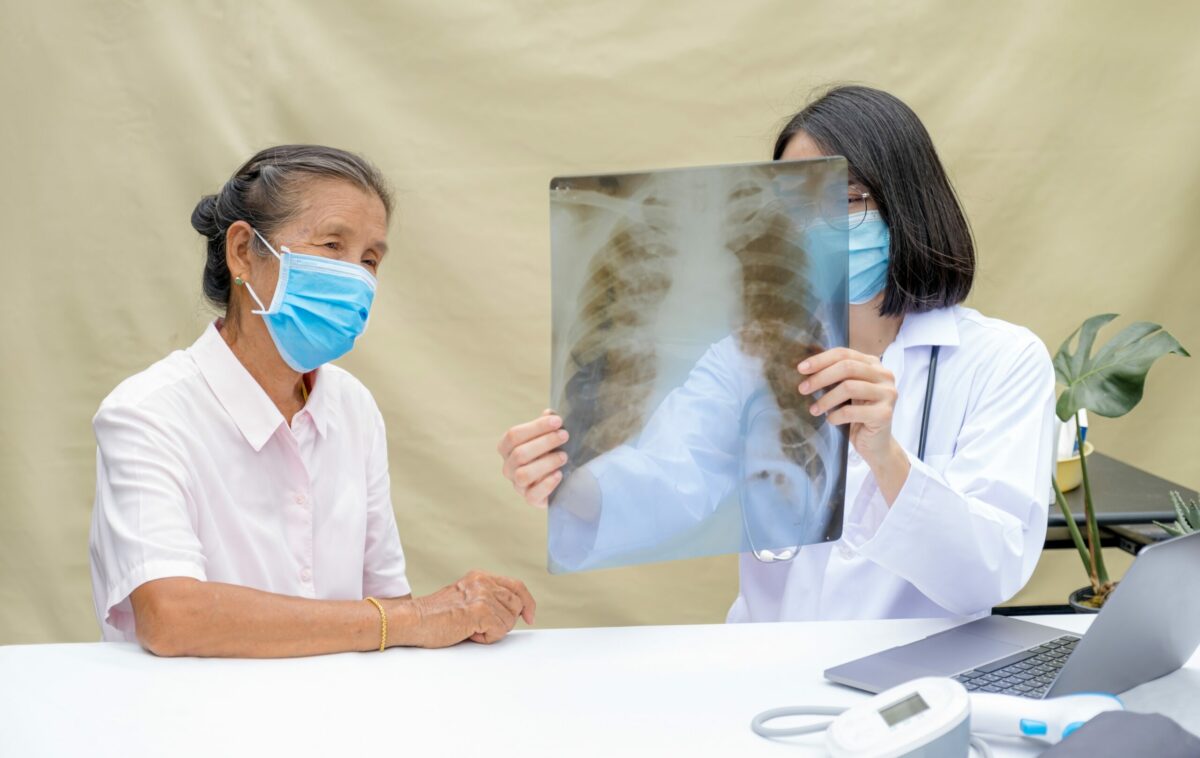This is a serious health condition that affects the lungs. It is known as tuberculosis (TB) and the primary cause of this disease is germs (a type of bacteria). This condition can spread from one person to another through coughs and sneezes. It happens because, through cough and sneezing, you can put some droplets of the germs into the air which another person breathes in. Therefore, the germs enter the lungs and provoke the condition.
TB easily spreads where people live in crowded conditions. Moreover, those who suffer from HIV infection or have weakened immune systems are also at increased risk of getting tuberculosis. The main treatment for this lung disease is antibiotics but some forms of bacteria may not respond well to these medications.
Symptoms
Once tuberculosis germs survive and start to multiply in the lungs, it is known as a tuberculosis infection. Experts classify this infection into 3 stages and each one has different symptoms.
Primary Tuberculosis Infection
This stage is known as primary infection and the body’s defense (immune system) finds and destroys these germs. However, in some cases, germs can survive and continue to multiply. Most people with primary infection usually do not experience any symptoms while others notice flu-like symptoms. Examples include:
- Low fever
- Tiredness
- Cough
Latent Tuberculosis Infection
This stage occurs after primary infection and the body’s defense begins to build a wall around the lung tissue with tuberculosis germs. In other words, the immune system helps to keep them under control and germs cannot do any harm. In any case, these germs survive while people do not experience any symptoms.
Active Tuberculosis Disease
People experience this tuberculosis stage when the body’s defense cannot control the infection. As a result, germs provoke disease throughout the lungs or other body parts. Some people may experience active tuberculosis disease promptly after primary infection. Generally, this stage of tuberculosis appears in people with latent tuberculosis infection after months or years. Check below some symptoms of tuberculosis disease that commonly begins gradually and worsens over time:
- Cough
- Breathing or coughing pain
- Chest pain
- Night sweats
- Weight loss
- Lack of appetite
- Chills
- Fever
- Bloody cough
- Tiredness
Active Tuberculosis Outside the Lungs
This condition can spread from the lungs to other body parts and it is known as extrapulmonary tuberculosis. The symptoms a person will experience depend on which part of the body is affected. Check below some common symptoms:
- Fever and chills
- Night sweats
- Pain near the infection site
- Fatigue
- Unexplained weight loss
In addition, if you experience active tuberculosis disease in the voice box, the symptoms will be similar to those that appear due to lung disease. Check below the most common sites of active tuberculosis disease outside the lungs:
- Liver
- Kidney
- Heart muscles
- Genitals
- Lymph nodes
- Bones and joints
- Skin
- Blood vessel walls
- Voice box (larynx)
- Spinal cord and brain fluid
Active Tuberculosis Disease in Children
The symptoms that appear in children are fluctuating often. Examples include:
- Teenagers – In such cases, symptoms are very similar to adult ones.
- 1-12 years old – Persistent fever and weight loss are commonly noticed.
- Infants – Being not active, unusually fussy, vomiting, poor feeding, bulging soft spot on the head, and poor reflexes can occur in infants with this type of tuberculosis.
In case you notice chest pain, sudden and severe headaches, confusion, seizures, breathing problems, bloody cough, and blood in the urine or stool immediately contact your healthcare professional.
Causes
The bacterium that provokes this lung disease is known as Mycobacterium tuberculosis. Those who suffer active tuberculosis disease in the voice box or lungs can spread the condition to other people. It occurs because you release small droplets into the air that carry this bacteria. Commonly it happens when you are speaking, singing, laughing, coughing, or sneezing.
In most cases, this condition spreads in indoor spaces. For instance, where people work or live for long periods. Another place where the condition can spread to other people is crowded gatherings.
Furthermore, if you experience the latent form of this disease or use medications for active tuberculosis disease for at least 2-3 weeks, the condition cannot pass to other people.
Drug-resistant Tuberculosis
There are some tuberculosis forms that can become drug-resistant and the medicines once cured the disease will no longer work. It usually occurs due to genetic changes in the bacteria. In other words, specific genetic mutation of the bacteria makes it more likely to survive an antibiotic attack. When the bacteria survive it can multiply.
Additionally, if you are not using antibiotics correctly or they are not effective, the bacteria become more resistant and continue to multiply. If someone gets these bacteria, over time a new drug-resistant strain can develop.
Check below some problems that could lead to drug-resistant bacteria strains:
- Medicines were not available
- Poor quality of medications
- The body did not absorb the medications as expected
- A person does not get the correct treatment plan
- People who do not follow exactly the treatment
Risk Factors
While anyone can get this condition, there are some factors that could elevate your risk. According to the Centers for Disease Control and Prevention, you should get tested for tuberculosis if you are at higher risk of developing tuberculosis infection or active tuberculosis disease. It is advised to consult with your doctor if you have one or more of the following risk factors.
Risk of Tuberculosis Infection
Some working or living condition leads to the easy spread of tuberculosis to other people. Examples include:
- Living with someone with active TB disease
- Traveling where tuberculosis is common including Latin America, Africa, Asia, and the Pacific Islands.
- Working or living in locations where people stay close together (such as prisons, nursing homes, shelters for homeless people, and others)
- Living in high-risk tuberculosis communities
- Working in places and treating people with tuberculosis
Risk of Active Tuberculosis Disease
The risk of getting active tuberculosis disease. Check below some medical conditions that may lead to a weakened immune system:
- Severe kidney disease
- HIV/AIDS
- Diabetes
- Cancer
- Low body weight
- Cancer treatment (including chemotherapy)
- Medicines to prevent rejection of transplant organs
- Recreational drugs
- Misuse of alcoholic drinks
- Smoking
Age and Active Tuberculosis Disease
- Under 5 years old – Children who do not reach 5 years old are more likely to develop a tuberculosis infection. Moreover, this condition can provoke a serious health condition in the fluid that surrounds the brain and spinal cord (meningitis).
- 15-25 years old – People who are between this range have an elevated risk of developing more severe active tuberculosis disease in the lungs.
- Age 65 and older – The immune system weakens on its own with aging and older people have an increased risk of developing active tuberculosis disease. In such cases, treating this lung disease may be more challenging.
Diagnosis
Physicians often diagnose this condition by asking you questions about symptoms, checking for swollen lymph nodes, and listening to your breathing using a stethoscope. In any case, if they are not sure you have tuberculosis, you may need to do some tests that will help to confirm the condition. Examples include:
Skin Test
A small amount of substance is injected under the skin of the forearm and after 48-72 hours doctors will check for swelling. The size of the skin can help doctors determine a positive or negative test. In case you have a positive test you may have a latent TB infection or active TB disease. Those who get a tuberculosis vaccine may get a positive test but do not have the infection. If you have a negative test means that the body does not react to the test but not necessarily you do not have an infection.
Blood Tests
Blood tests are used to determine which type of tuberculosis you have. A negative test usually means you do not have tuberculosis.
X-ray
This test helps to make pictures of the lungs to check for irregular patches in the lungs. These patches usually appear in people with active tuberculosis disease.
Sputum Test
Healthcare professionals may also take a sample of sputum (mucus that appears when you cough) to check for bacteria that provoke tuberculosis.
Other Laboratory Tests
The following tests also may help to confirm this lung disease. Examples include:
- Breath test
- Urine test
- Cerebrospinal fluid test
Treatment
In case you were diagnosed with latent TB infection, physicians will start the treatment. The treatment usually lasts 3-4 months. However, if you were diagnosed with active tuberculosis disease, the treatment may last up to one year.
Additionally, it is recommended to follow the treatment exactly as prescribed by your doctor. Otherwise, the bacteria will continue to multiply or you may have drug resistance.
In case you have a latent TB infection, physicians may prescribe 1-2 medicines but in active tuberculosis disease, you can get a prescription of more medicines. Check below the most common medications used to treat tuberculosis:
- Isoniazid
- Pyrazinamide
- Ethambutol
- Rifabutin
- Rifampin
- Rifapentine
Additionally, check below the potential adverse reactions of previous medicines:
- Vomiting
- Stomach discomfort
- Loss of appetite
- Severe diarrhea
- Dark urine
- Yellowing of the skin or eyes
- Dizziness
- Vision problems
- Easy bruising or bleeding
- Tiredness
- Depression
- Rash
- Joint pain
Talk with your doctor before taking any medicine. Otherwise, medicines may not work for you or worsen the condition.
Frequently Asked Questions
Is it possible to prevent tuberculosis?
If you were diagnosed with tuberculosis, you need medicines to prevent active tuberculosis disease. Moreover, it is advised to follow the tips below to prevent spreading the infection to other people. For example:
- Stay home
- Isolate at home
- Ventilate the room regularly
- Wear face masks
- Cover the mouth when you sneeze or cough
Can tuberculosis be cured?
If you are following the treatment exactly as prescribed by your physician, it is possible to cure the infection.
What are tuberculosis complications?
Not treating this infection may lead to certain complications. For example:
- Heart tissue inflammation
- Kidney or liver problems
- Infection of the bones, spinal cord, brain, skin, or lymph nodes
- Lung and joint damage
If you experience any of the complications listed above, immediately contact your healthcare professional. In case you have additional questions, ask your doctor.




